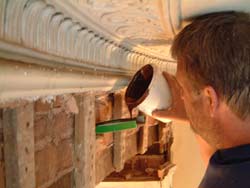EPOXY RESINS
Some background information
Epoxy Resins have been in commercial use since before the Second World War and were originally developed for the Aircraft Industry.
Epoxies have an extensive history of applications in high-tech and high strength applications because they are resistant to most chemicals and once 'cured' give off no vapour. They have no significant shrinkage during curing, so can be used in precision applications.
Typical resins used in the Construction and Building Repair Industry fall into three main groups;
1. Structural Pouring Resins
2. Structural Injection Resins
3. Structural Fillers
They all share a common characteristic in that at least two component parts have to be mixed together and that, once mixed fully, the mixture will chemically set.
However, setting and curing times are temperature sensitive. Most epoxies stop curing below 5 degrees Centigrade so we use a variety of fast and slow setting curing agents to adjust the formulations to suit the task.
Small unit sizes (say 1 litre) often incorporate any filler or colour pigments into one of the parts, resulting in a two part product.

Hand mixing a 2 part epoxy
Larger sizes (say 2.5 litres +) usually have any powder filler, and sometimes the colour pigments, made up into three parts, to prevent any mixing problems and ensure uniform quality.

Paddle mixing a 3 part epoxy
The mixing of the components is very important, because unlike Polyesters, Epoxies will never harden and cure if the two or three component parts are not in good contact. They will not air dry and the parts will remain sticky.

Pouring Structural Epoxy Resin
The pouring resins are self levelling and self de-gassing. That is, they slowly sink down and find a natural level, but also incorporate special chemicals that cause any air bubbles, trapped during the mixing process, to come to the surface before the product sets.
The Injection Resins are usually Thixotropic, so that they only flow when pushed from a cartridge, using a hand, electric or air powered skeleton gun. They do not run or self-level and can even be injected overhead without dripping. They can also be used without a cartridge as laminating or bonding adhesives, for example when scarfing in a timber or filling splits with timber 'slips'.

Injection Resin Kit - 1 litre
Epoxy fillers can be used structurally, as well as for cosmetic finishing.
Hand mixed Epoxy Mouldable Putty is extensively used for filling holes, cracks, slots and voids of all shapes and sizes, sometimes entirely and sometimes in conjunction with other finishing fillers that are ultra smoothable (for example, in restoring sash window frames).

Mixing Mouldable Epoxy Putty by hand
The Epoxy Resins are commonly combined with reinforcement bars made of steel, epoxy-glass or stainless steel, which act as shear connectors, dowels or act in bend.

CASE STUDY -
Most lintols and bressumers spanning openings are straight. They are often formed of one, two or three beams set parallel, sometimes bolted together. Occasionally you find a steel plate inside ('flitched').
In all these case wet or Dry Rot can easily remove the structural strength completely. The rot usually starts in the damp areas - the bearing ends, but we also find mid section damage caused by plumbing leaks, valley gutter or flat roof leaks.

Curved Lintols affected by Dry Rot
These Lintols had been destroyed by Dry Rot and were structurally weakened.

The remains of one Lintol after removal
Once removed a Template was made to use in the creation of a new, Oak multi-part Timber-Resin Splice.
Here is the one set of new components, clearly showing the centre 'box' where the bars overlap.

Two part curved Lintol in Oak
The Kiln Dried English Oak was machined from 3 inch (75mm) stock and then laminated to the original Imperial size. This is necessary because we could not source any Kiln Dried Oak large enough in a single piece.
Curved Timber Lintol Repair
The exterior of the building was repaired, to remove the source of the moisture which had caused the Dry Rot.
Boron treatments were applied to the masonry to kill the Dry Rot and to reduce the risk of any further outbreak during the drying out period.
The new components were then fitted, one piece at a time, to fit into the original bearing spaces.
In order to pour the Structural Epoxy Pouring resin into the repair a piece of gutter was employed.

Small 'chute' being used for resin pour.
The final repair is fully structural and exceeds the strength of the original timber.

Completed Oak Timber-Resin Splices
In some cases these types of Lintol can be partly repaired.
If only one bearing end has decayed a new single end Timber-Resin Splice can be fitted.
If the centre of a Lintol has decayed we can use a double ended Timber-Resin Splice.
A central repair piece was made up to link to the outer parts, with reinforcement bars running through the middle. This cosmetic component was made in matching Oak to provide a 'shutter' box, which was pushed upwards into place and then filled with Structural Epoxy Pouring Resin.

Spanning hollow section, in Oak
The curved Lintol shown above was replaced without disturbing the rest of the building or its occupants - this is a major cost saving when compared with the alternative methods involving replacement in steel.
For more information: www.timber.org.uk or www.timber-repair.co.uk